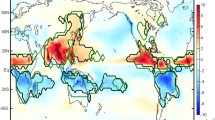Abstract
The responses of the East Asian summer monsoon (EASM) to large volcanic eruptions were analyzed using a millennial simulation with the FGOALS-gl climate system model. The model was driven by both natural (solar irradiance, volcanic eruptions) and anthropogenic (greenhouse gases, sulfate aerosols) forcing agents. The results showed cooling anomalies after large volcanic eruptions almost on a global scale. The cooling over the continental region is stronger than that over the ocean. The precipitation generally decreases in the tropical and subtropical regions in the first summer after large volcanic eruptions. Cooling with amplitudes up to −0.3 °C is seen over eastern China in the first summer after large volcanic eruptions. The East Asian continent is dominated by northeasterly wind anomalies and the corresponding summer rainfall exhibits a coherent reduction over the whole of eastern China. An analysis of the surface heat flux suggested the reduction in summer precipitation over eastern China can be attributed to a decrease of moisture vapor over the tropical oceans, and the weakening of the EASM may be attributed to the reduced land–sea thermal contrast after large volcanic eruptions.





Similar content being viewed by others
References
Lamb HH (1970) Volcanic dust in the atmosphere, with a chronology and assessment of its meteorological significance. Philos Trans R Soc Ser A 266:425–533
Cole-Dai J, Mosley-Thompson E, Thompson LG (1997) Annually resolved southern hemisphere volcanic history from two Antarctic ice cores. J Geophys Res 102:16761–16771
Gao CC, Oman L, Robock A et al (2007) Atmospheric volcanic loading derived from bipolar ice cores: accounting for the spatial distribution of volcanic deposition. J Geophys Res 112:D09109
Crowley TJ (2000) Causes of climate change over the past 1000 years. Science 289:270–277
Stowe L, Carey R, Pellegrino P (1992) Monitoring the Mt. Pinatubo aerosol layer with NOAA/11 AVHRR data. Geophys Res Lett 19:159–162
Trepte CR, Veiga RE, McCormick MP (1993) The poleward dispersal of Mount Pinatubo volcanic aerosol. J Geophys Res 98:18563–18573
Minnis P, Harrison EF, Stowe LL (1993) Radiative climate forcing by the Mount Pinatubo eruption. Science 259:1411–1415
Robock A, Mao J (1992) Winter warming from large volcanic eruptions. Geophys Res Lett 19:2405–2408
Allen MR, Ingram WJ (2002) Constraints on the future changes in climate and the hydrological cycle. Nature 419:224–232
Gillett NP, Weaver AJ, Zwiers FW et al (2004) Detection of volcanic influence on global precipitation. Geophys Res Lett 31:L12217
Lambert FH, Gillett NP, Stone DA et al (2005) Attribution studies of observed land precipitation changes with nine coupled models. Geophys Res Lett 32:L18704
Trenberth KE, Dai AG (2007) Effects of Mount Pinatubo volcanic eruption on the hydrological cycle as an analog of geoengineering. Geophys Res Lett 34:L15702
Robock A, Liu Y (1994) The volcanic signal in Goddard Institute for Space Studies three-dimensional model simulations. J Clim l7:44–55
Portman DA, Gutzler DS (1996) Explosive volcanic eruptions, the El Niño-Southern Oscillation, and U.S. climate variability. J Clim 9:17–33
Xu Q (1986) The abnormal weather of China for summer 1980 and its relationship with the volcanic eruptions of Mount St. Helens. Acta Meteorol Sin 44:426–432 (in Chinese)
Shen CM, Wang W-C, Hao ZX et al (2007) Exceptional drought events over eastern China during the last five centuries. Clim Change 85:453–471
Shen CM, Wang W-C, Hao ZX et al (2008) Characteristics of anomalous precipitation events over eastern China during the past five centuries. Clim Dyn 31:463–476
Sato M, Hansen J, McCormic M et al (1993) Stratospheric aerosol optical depths, 1850–1990. J Geophys Res 98:2987–2994
Zhou TJ, Wu B, Wen XY et al (2008) A fast version of LASG/IAP climate system model and its 1000-year control integration. Adv Atmos Sci 25:655–672
Wen XY, Zhou TJ, Wang SW et al (2007) Performance of a reconfigured atmospheric general circulation model at low resolution. Adv Atmos Sci 24:712–728
Liu HL, Zhang XH, Li W et al (2004) An eddy-permitting oceanic general circulation model and its preliminary evaluations. Adv Atmos Sci 21:675–690
Bonan GB, Oleson KW, Vertenstein M et al (2002) The land surface climatology of the Community Land Model coupled to the NCAR Community Climate Model. J Clim 15:3123–3149
Briegleb BP, Bitz CM, Hunke EC et al (2004) Scientific description of the sea ice component in the Community Climate System Model: Version Three. NCAR Tech. 2004, Note NCARTN-463+STR
Crowley T, Baum S, Kim K-Y et al (2003) Modeling ocean heat content changes during the last millennium. Geophys Res Lett 30:1932
Ammann C, Joos F, Schimel D et al (2007) Solar influence on climate during the past millennium: results from transient simulations with the NCAR Climate System Model. Proc Natl Acad Sci USA 104:3713–3718
Zhou TJ, Yu RC (2006) Twentieth century surface air temperature over China and the globe simulated by coupled climate models. J Clim 19:5843–5858
Peng YB, Shen CM, Wang W-C et al (2010) Response of summer precipitation over eastern China to large volcanic eruptions. J Clim 23:818–824
Li XD, Wang SW, Liu RX (1996) Advances in volcano-climatology. Seismol Geom Obs Res 17:74–80 (in Chinese)
Ammann C, Meehl G, Washington W et al (2003) A monthly and latitudinally varying volcanic forcing dataset in simulations of 20th century climate. Geophys Res Lett 30:1657
Acknowledgments
This work was supported by the National Natural Science Foundation of China (41305069), the Open Project Program of the Key Laboratory of Meteorological Disaster of Ministry of Education, Nanjing University of Information Science and Technology, China R&D Special Fund for Public Welfare Industry (meteorology) (GYHY201406020), and the National Basic Research Program of China (2010CB951904).
Conflict of Interest
The authors declare that they have no conflict of interest.
Author information
Authors and Affiliations
Corresponding author
About this article
Cite this article
Man, W., Zhou, T. Response of the East Asian summer monsoon to large volcanic eruptions during the last millennium. Chin. Sci. Bull. 59, 4123–4129 (2014). https://doi.org/10.1007/s11434-014-0404-5
Received:
Accepted:
Published:
Issue Date:
DOI: https://doi.org/10.1007/s11434-014-0404-5




